Notes: Farnworth & Bold Station was situated on the St Helens and Runcorn Gap Railway (SH&RGR) which had its official opening on 21 February 1833. The line was authorised on 29 May 1830 and ran from St Helens in the north to the banks of the River Mersey at Widnes just east of the Runcorn Gap (a narrow point in the river where a ferry operated). At Widnes the SH&RGR had its own dock (Widnes Dock – which did not open until August 1833) at which goods were transferred between rail and water.
was far more financially stable and could think about expansion and improvements. As built the railway included two inclined planes one of which was just north of Widnes to the south of Farnworth; the other was at Sutton in St Helens. Both inclines were cable-worked and were an impediment to traffic growth as only a few wagons at a time could be hauled up or lowered down. The line had also been built as a single-track railway. On the 22 July 1847 the SHC&RC received Royal Assent to create a double-track railway and to level out the inclined planes so that locomotives could work along the entire length of the line. The inclined plane to the south of Farnworth was levelled out by creating a new alignment slightly east of the original, and it was ready for traffic by the end of 1850. Although the planes had been levelled they were anything but level and still represented a considerable gradient; however they could be worked by locomotives.
Passenger journey times between St Helens and Widnes improved dramatically, being only 25 minutes. It was following these developments that intermediate stations were opened along the line that first appeared in the timetable in June 1852.
In 1852 Farnworth & Bold was known simply as Farnworth. It was less than half-a-mile east of the village from which it took its name and was situated on the north side of a level crossing that carried Derby Road across the line. A crossing keeper’s cottage was located on the east side of the line south of the road. It predated the station and may have been used to sell tickets at first. Within a few years, however the station had been provided with a single-storey brick building on the up (St Helens direction) platform which housed a booking hall, booking office, waiting rooms and toilets. A simple waiting shelter was provided on the down (Widnes direction) platform. On the west side of the line behind the up platform was a goods yard with two sidings.
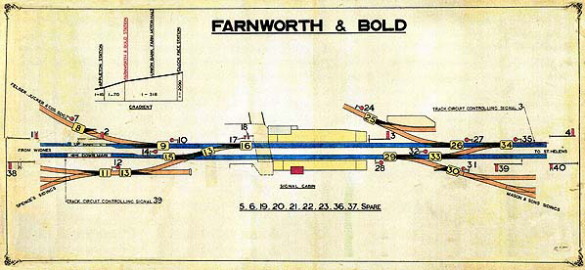 |
At the time of opening passenger trains would have operated between Runcorn Gap (Widnes) and St Helens. By July 1852 the SHC&RC had opened an extension of the line from Widnes to Garston and this resulted in some of the passenger train services running on to the latter.
On the 31 July 1864 Farnworth station became part of the London & North Western Railway (LNWR). This company carried out further improvements to the line which had become a very busy freight artery. Factories had sprung up along its route, including at Farnworth. By 1874 there was a manure works to the east of the station and by the 1890s a brick works had opened just to the west. Also by the 1870s a bridge had been constructed north of the station and Derby Road was diverted to run over it. The level crossing was taken out of use although the keeper’s cottage survived. During the 1870s a signal box was opened at Farnworth. It was located towards the southern end of the down platform and was a Saxby & Farmer Type 6 brick-built box with a 17-lever frame.
On 2 January 1890 Farnworth station was renamed Farnworth & Bold. This was to avoid confusion with a station that had been opened on the west side of Farnworth by the Cheshire Lines Railway (CLC) in 1873 and which they named Farnworth.
By the early part of the twentieth century large factories had developed just south of Farnworth & Bold station on both the east and west sides of the line. A large wood yard had also developed on the north side of the Derby Road bridge. All of these facilities were rail-served and each provided passengers for the station. Train services had settled into being of a local nature although excursions to more distant locations did run.
 From the 1 November 1911 the LNWR introduced a rail-motor service on the line, and to coincide with its introduction they opened two halts one of which was just over a mile north of Farnworth & Bold at Union Bank Farm. The service was very popular with local people and was known as the ‘Ditton Dodger’ as it ran between Ditton Junction and St Helens Shaw Street. At Ditton Junction connections to Liverpool, Crewe, Manchester and even London could be made. It was not long before the rail-motor was inadequate for the service, and it was replaced with Webb tank locomotives and coaches which could be operated as push-and-pull sets. The name ‘Ditton Dodger’ however stuck and the service was referred to by this name until it ceased to run. From the 1 November 1911 the LNWR introduced a rail-motor service on the line, and to coincide with its introduction they opened two halts one of which was just over a mile north of Farnworth & Bold at Union Bank Farm. The service was very popular with local people and was known as the ‘Ditton Dodger’ as it ran between Ditton Junction and St Helens Shaw Street. At Ditton Junction connections to Liverpool, Crewe, Manchester and even London could be made. It was not long before the rail-motor was inadequate for the service, and it was replaced with Webb tank locomotives and coaches which could be operated as push-and-pull sets. The name ‘Ditton Dodger’ however stuck and the service was referred to by this name until it ceased to run.
In 1920 the LNWR replaced the Saxby & Farmer signal box with an LNWR Type 5. The new box was also located on the down platform but slightly north of the original. It had a brick base and timber upper cabin and was provided with a 40-lever frame; the larger frame indicates the growth in industry around Farnworth & Bold by this time.
On 1 January 1923 Farnworth & Bold station became part of the London Midland & Scottish Railway (LMS). Very little changed, and the service continued to run between Ditton Junction and St Helens Shaw Street. The LMS summer timetable for 1932 had thirteen trains leaving Farnworth & Bold for St Helens and thirteen trains for Ditton Junction on weekdays. Additional trains ran on Saturdays.
During the Second World War the passenger service was cut back to only six trains per day in each direction, and they ran only in the morning and evening peak hours. There were midday services on Saturdays for shoppers but, in the main, the line was given over to goods services and troop trains. At the end of the War the services at Farnworth & Bold remained sparse although the trains that did run were popular with local people for travelling to work and for Saturday shopping trips.
On 1 January 1948 Farnworth & Bold became part of the nationalised British Railways (London Midland Region). The 1949 summer timetable had only six up and six down trains on Monday-to-Friday, with a long gap during the daytime. On Saturdays there were retimed workings and a midday service.
British Railways wanted to concentrate on goods services so they proposed that the St Helens Shaw Street and Ditton Junction passenger service be withdrawn. Despite local protest, and the replacement bus service taking considerably longer, passenger services were withdrawn on the 16 June 1951 and the ‘Ditton Dodger’ was no more.
Farnworth & Bold remained open for goods and was listed in the 1956 British Transport Commission Hand-book of stations as having a crane capable of lifting 15cwt. It also possessed private sidings for Lloyds Packing Warehouses Ltd, the Mulsoid Company, Spence & Son’s and for the Turners Asbestos Company. Numerous trip workings were operated to Farnworth & Bold, mostly from Widnes. The Farnworth & Bold trips were given the number T86. The station also saw a large amount of through freight trains during the period. Since the earliest of days southbound heavy freight trains had to stop at Farnworth & Bold to pin down their brakes. A large notice board reminded crews that they had to do this. It was located adjacent to the crossing keeper’s cottage. The brakes had to be pinned down owing to the steep gradient between Farnworth & Bold and Appleton. Trains travelling northbound often had to be assisted up to Farnworth by a banking engine. The banking engines would stop at Farnworth & Bold station after pushing trains up the bank and wait for a return path southward. Passenger trains would also pass through from time to time either as diverted ordinary workings or as specials. Many rugby league specials ran along the line. All of this activity made Farnworth & Bold a very busy place in the 1950s despite the loss of its passenger service.
The Reshaping of British Railways (Beeching Report) of March 1963 did not only recommend the withdrawal of many passenger services and stations it also had much to say about goods facilities. Although making no specific reference to stations, the report saw no future for such stations as Farnworth & Bold which, by the 1960s, was handling only one or two wagons per week. The main traffic to the station was for coal merchant E H Wilson & Son. Farnworth & Bold station closed to goods services on 1 June 1964.The goods yard sidings were lifted and, the along with the station building, they became part of a road haulage company depot.
Farnworth & Bold remained on the railway map as both Spence & Sons and the Turners Asbestos Company works continued to receive goods by rail. On 5 February 1966 the LCGB ‘Push & Pull Farewell’ rail tour was booked to stop at Farnworth & Bold for ten minutes to allow photographs to be taken.
In December 1967 the line from Widnes Junction to St Helens was reduced to goods line status although, interestingly, diverted passenger services continued to use it until the early 1980s. From this date the signal box was open only from 10:00 until 22:00 on Monday-to-Saturday but, with effect from 14 December 1969, the line was singled from a point north of Derby Road bridge through to Sutton Oak. The Farnworth & Bold signal box took on an important role as trains had to stop to collect or pick up the single-line tokens that were required for the section to Sutton Oak. Because of this the signal box opening hours were altered to 06:00 until the last train had passed on Monday-to-Saturday.
 The box also controlled the twice-daily trip workings from Widnes Hutchinson Street Yard to the Turners Asbestos Company factory which was adjacent to the station. The trip brought in Prestflo cement wagons from Hope in Derbyshire which carried tickets reading ‘Hope to Farnworth & Bold’. In the late 1960s one of these trip workings derailed as it was leaving the factory and the wagons fell against the former northbound platform of Farnworth & Bold station causing damage to the southern end of it. The trip workings to the Spence & Sons’ works had ceased by the early 1970s. The box also controlled the twice-daily trip workings from Widnes Hutchinson Street Yard to the Turners Asbestos Company factory which was adjacent to the station. The trip brought in Prestflo cement wagons from Hope in Derbyshire which carried tickets reading ‘Hope to Farnworth & Bold’. In the late 1960s one of these trip workings derailed as it was leaving the factory and the wagons fell against the former northbound platform of Farnworth & Bold station causing damage to the southern end of it. The trip workings to the Spence & Sons’ works had ceased by the early 1970s.
With effect from 4 November 1973 the section of line from Farnworth & Bold to Widnes No. 1 box was singled and Farnworth & Bold box was closed. The former down line became the bi-directional single track. At the station site a section of the former up line was retained from a point 413yd south of the station to a point several hundred yards to the north of the Derby Road bridge. The former up line was designated as the ‘up siding’ and provided access to the Turners Asbestos Company works and a run-round loop for the trip workings. The siding was controlled by two ground frames designated as Farnworth & Bold numbers 1 and 2. No.1 ground frame was at the south end of the up platform and No. 2 was beyond Derby Road bridge at the point where the line had become single after 14 December 1969. The ground frames were controlled by a token released from either Widnes No. 1 or Sutton Oak signal boxes.
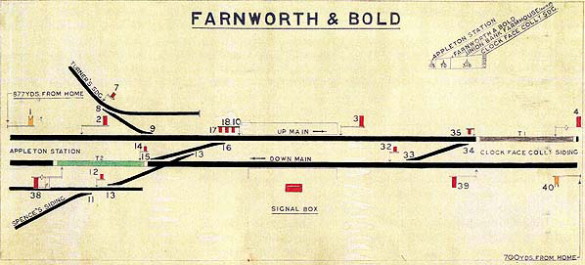 |
Until Farnworth & Bold signal box closed the station remained in relatively good repair, but its platforms became choked with vegetation after 1973.
When the Turners Asbestos Company announced that it would no longer use the railway to bring in materials British Rail decided to close the line as a through route and divert through trains. It announced its intention to close the line in 1981, but as it had been thirty years since passenger services had run the decision caused no protest. The line closed as a through route on 1 November 1981. The last rail movement was a light engine which passed through the station on its way to Wigan on Saturday 31 October 1981. The engine was Class 40 No. 40 124 driven by George Vernon. The following day the line was severed just over a mile north of Farnworth & Bold. Officially it remained open from Widnes Junction to Farnworth & Bold until 18 April 1982, but no rail movements occurred north of Widnes No. 1 signal box after 31 October 1981. Track-lifting at Farnworth & Bold had been completed by 15 March 1982 when the remaining sleepers were recovered by lorry.
The station building had been gutted by fire shortly before the line closed but in the mid-1980s it was refurbished and, in a much altered state, served as industrial premises until the early 1990s. In 1993 the station site was obliterated by the construction of the Watkinson Way bypass road.
The 8D Association - Dedicated to promoting the history of South Lancashire and North Cheshire railways. Web Site
Tickets from Michael Stewart and Paul Wright, Bradshaw from Nick Catford and route map by Alan Young
Sources:
- Bradshaws July 1922 Railway Guide July 1922 - Guild Publishing 1986
- Bradshaws Rail Times December 1895 - Middleton Press 2011
- British Railways (London Midland Region) Summer Timetable 1949
- Disused Stations - Lost Stations of North West England - P T Wright - Silverlink Publishing 2011
- Handbook of Stations - British Transport Commision 1956
- Industrial Railways of St Helens, Widnes and Warrington - Part 2 St Helens Coalfield and the Sandfields - C H A Townley & J A Peden - Industrial Railway Society 2002
- Journey of A Railway Signalman - T Cook - Cook Publishing 2016
- LMS Time Table Summer 1932
- The St Helens Railway, Its Rivals and Successors – J M Tolston – The Oakwood Press 1982
- The Widnes to St Helens Railway in Halton 1833 - 1982 - P T Wright - Halton Borough Council 2008
To read about passenger train services at Farnworth & Bold click here
To see photos showing the lifting of the St Helens line at
Farnworth & Bold click here
For photos showing the sidings at the Turners Asbestos Company
Everite
works click here
To see the other stations of the St. Helens & Runcorn Gap Railway click on the station name: Runcorn Gap, Ann Street, Appleton, Union Bank Farm Halt,
Clock Face, Sutton Oak, Peasley Cross, St Helens 1st, St Helens 2nd &
St Helens 3rd
See also:
Widnes 1st, Widnes South, Ditton
|

bold_old2.jpg)
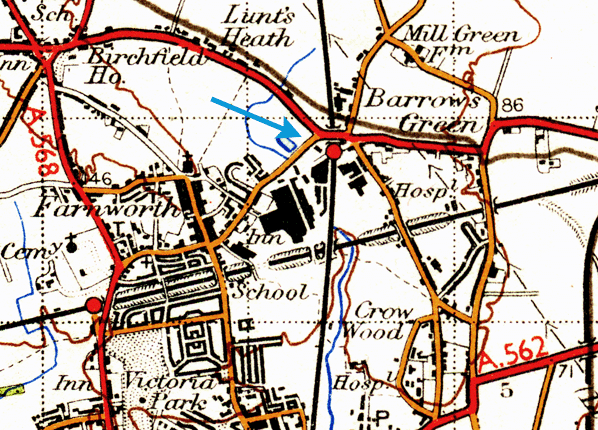
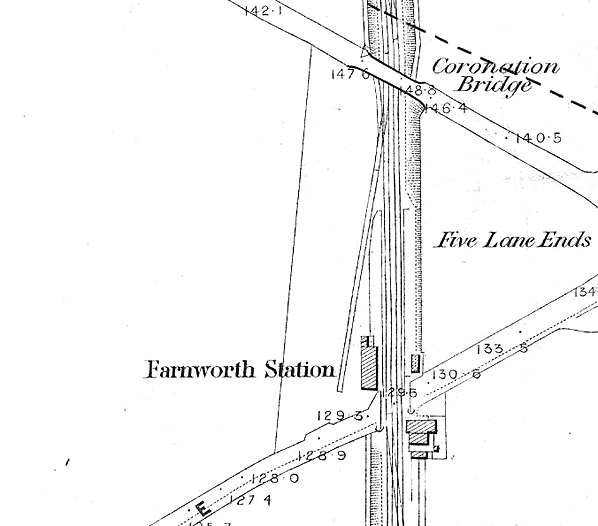
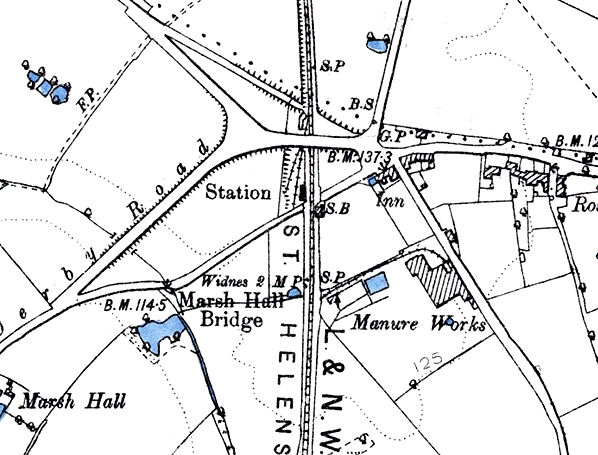
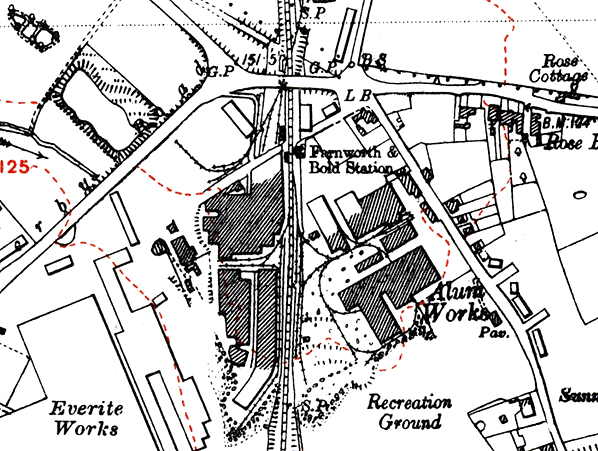
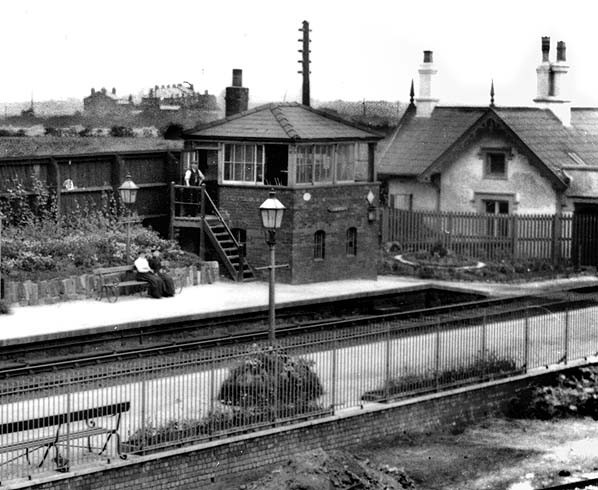
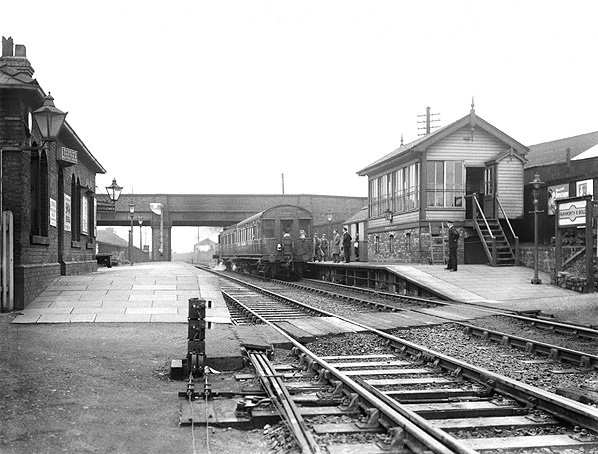
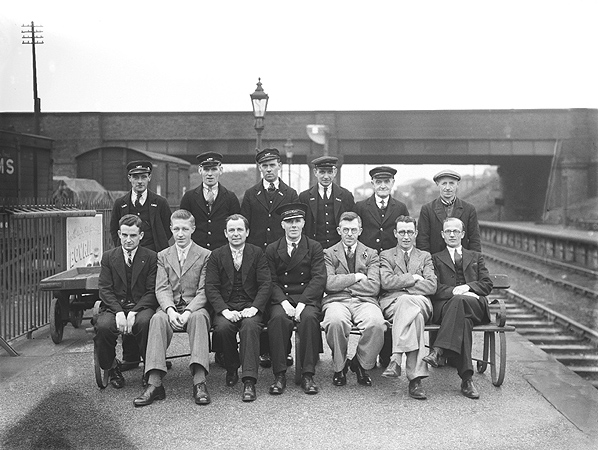
old2.jpg)
.jpg)


 From the 1 November 1911 the LNWR introduced a rail-motor service on the line, and to coincide with its introduction they opened two halts one of which was just over a mile north of Farnworth & Bold at Union Bank Farm. The service was very popular with local people and was known as the ‘Ditton Dodger’ as it ran between Ditton Junction and St Helens Shaw Street. At Ditton Junction connections to Liverpool, Crewe, Manchester and even London could be made. It was not long before the rail-motor was inadequate for the service, and it was replaced with Webb tank locomotives and coaches which could be operated as push-and-pull sets. The name ‘Ditton Dodger’ however stuck and the service was referred to by this name until it ceased to run.
From the 1 November 1911 the LNWR introduced a rail-motor service on the line, and to coincide with its introduction they opened two halts one of which was just over a mile north of Farnworth & Bold at Union Bank Farm. The service was very popular with local people and was known as the ‘Ditton Dodger’ as it ran between Ditton Junction and St Helens Shaw Street. At Ditton Junction connections to Liverpool, Crewe, Manchester and even London could be made. It was not long before the rail-motor was inadequate for the service, and it was replaced with Webb tank locomotives and coaches which could be operated as push-and-pull sets. The name ‘Ditton Dodger’ however stuck and the service was referred to by this name until it ceased to run.

 The box also controlled the twice-daily trip workings from Widnes Hutchinson Street Yard to the Turners Asbestos Company factory which was adjacent to the station. The trip brought in Prestflo cement wagons from Hope in Derbyshire which carried tickets reading ‘Hope to Farnworth & Bold’. In the late 1960s one of these trip workings derailed as it was leaving the factory and the wagons fell against the former northbound platform of Farnworth & Bold station causing damage to the southern end of it. The trip workings to the Spence & Sons’ works had ceased by the early 1970s.
The box also controlled the twice-daily trip workings from Widnes Hutchinson Street Yard to the Turners Asbestos Company factory which was adjacent to the station. The trip brought in Prestflo cement wagons from Hope in Derbyshire which carried tickets reading ‘Hope to Farnworth & Bold’. In the late 1960s one of these trip workings derailed as it was leaving the factory and the wagons fell against the former northbound platform of Farnworth & Bold station causing damage to the southern end of it. The trip workings to the Spence & Sons’ works had ceased by the early 1970s.
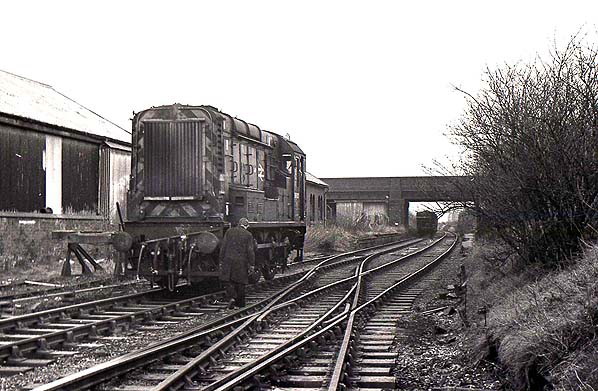
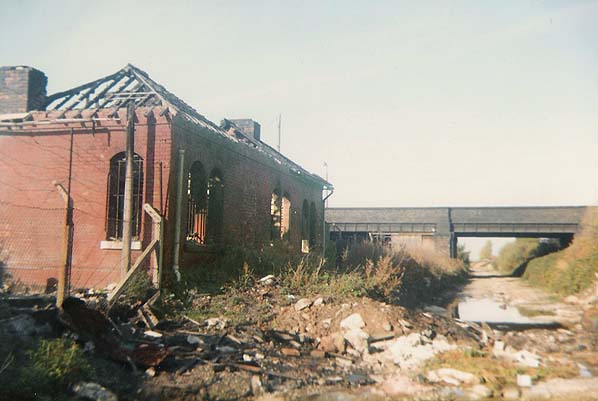

 Home Page
Home Page